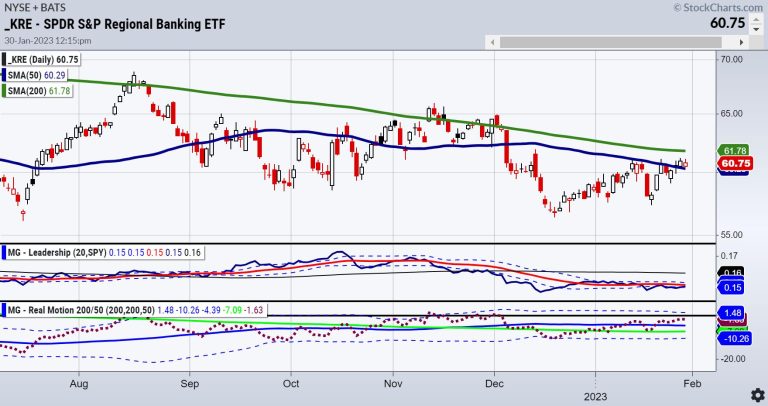Nearly every member of Mish’s Modern Family improved last week, with the Russell 2000 (IWM), Transportation (IYT), Semiconductors (SMH), and Retail (XRT) all putting in Golden Crosses on their daily charts.
Except for Regional Banks (KRE).
Risk off or on during this data heavy week? Clearly, the performance of MarketGauge’s Trend Strength Indicator (TSI) improving across all 4 key indices, with Small Caps (IWM) and the Dow (DIA) leading the bunch points to risk on. However, some areas should keep investors on their toes.
The 52-week New High / New Low ratio for the Nasdaq Composite has actually begun to deteriorate, a clear Risk-Off indication for the short term. And, despite the improvement in the market, the Yield Curve has actually continued to invert further.
KRE has not had a golden cross (the 50 daily moving average clears above the 200-DMA). It sits atop the 50-DMA, true. Nonetheless, looking out a wee bit at the weekly chart, KRE has yet to clear resistance and way underperforms the rest of the family. We have seen this before. KRE’s momentum, according to our Real Motion Indicator shows a bullish cross from last November. Yet the price has done nothing but decline in momentum since the since then.
Another member of the Economic Modern Family, Transportation, is also flashing a warning on the weekly chart.
Note that IYT has failed to clear the 50-week moving average (blue line). Also note the slope on the 50-WMA is negative.
IYT is beginning to underperform the SPY and momentum, according to Real Motion is slipping lower. Also interesting to observe is that the momentum moving averages had a death cross in early November.
Transportation and Regional Banks make up nearly 1/3 of the Economic Modern Family.
Of course, the week is young, so we have time to see if both sectors play catch up or are sending us a meaningful warning message. Either way, they are not to be ignored.
For more detailed trading information about our blended models, tools and trader education courses, contact Rob Quinn, our Chief Strategy Consultant, to learn more.
You don’t want to miss Mish’s 2023 Market Outlook, E-available now!
Click here if you’d like a complimentary copy of Mish’s 2023 Market Outlook E-Book in your inbox.
“I grew my money tree and so can you!” – Mish Schneider
Get your copy of Plant Your Money Tree: A Guide to Growing Your Wealth and a special bonus here.
Follow Mish on Twitter @marketminute for stock picks and more. Follow Mish on Instagram (mishschneider) for daily morning videos. To see updated media clips, click here.
Mish in the Media
Kristin and Mish discuss whether or not the market has run out of good news in this appearance on Cheddar TV.
Harry Melandri and Mish discuss inflation, the Federal Reserve, and all the sparkplugs that could ignite on Real Vision.
Jon and Mish discuss how the market (still rangebound) is counting on a dovish Fed in this appearance on BNN Bloomberg.
Mish discusses price and what indices must do now in this appearance on Making Money with Charles Payne.
In this appearance on TheStreet.com, Mish and JD Durkin discuss the latest market earnings, data, inflation, the Fed and where to put your money.
In this appearance on CMC Markets, Mish digs into her favourite commodity trades for the week and gives her technical take on where the trading opportunities for Gold, oil, copper, silver and sugar are.
ETF Summary
S&P 500 (SPY): Resistance met and price retreated 390-400 to hold.Russell 2000 (IWM): More worrisome as we had a glass ceiling high. Could mean a visit to 177 if cant clear Fri highs.Dow (DIA): Gentler correction, which has boded well for the industrials since December.Nasdaq (QQQ): Like IWM a glass ceiling high. 280 not crazy to see.Regional Banks (KRE): Keep watching to see if holds 60 then 57.Semiconductors (SMH): Like IWM, QQQ could see a 5-10% decline from here.Transportation (IYT): Most obvious failure of the 50-week MA.Biotechnology (IBB): Multiple timeframes count and this failed the 23-month MA so far.Retail (XRT): This sector held up better–if Granny’s brethren fall tho, XRT can make its way back to 64.
Mish Schneider
MarketGauge.com
Director of Trading Research and Education

